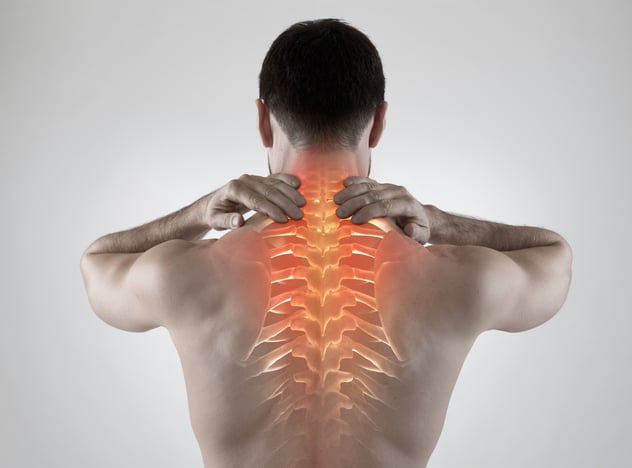
Back pain and general muscle soreness are common problems for many people. Understanding correct force postures and maintaining your musculoskeletal system will help to both treat and prevent pain and disease.
What causes musculoskeletal pain?
The most common causes of musculoskeletal pain are soft tissue injuries (such as car accidents and sports injuries) and aging. Qi stagnation, Blood stasis, poor posture, and some life factors such as lack of exercise and excessive muscle use, can also contribute. In addition, dietary factors, mental factors, and other diseases such as cancer, gastrointestinal discomfort, dysmenorrhea, etc. can cause musculoskeletal pain.
The above factors cause muscle contraction, vasospasm, lactic acid accumulation, accumulation of inflammatory substances, and nerve excitement. They also lead to spasms of muscle and blood vessels which are not easily relieved, causing more metabolites to be developed. Such an abundance of inflammatory substances is too much to be taken away by normal blood flow, leading to a vicious cycle of dysfunction of muscle contraction and metabolism. Then the body will feel soreness, pain, pressure and tingling. So any methods which can increase blood circulation would be excellent ways to treat musculoskeletal pain!
What are the correct postures to prevent musculoskeletal pain?
The most common musculoskeletal pains are due to poor posture; for example, back pain. Being aware of correct posture during all activities can prevent back pain, but most especially when:
1. Picking up items
Bend your knees instead of bending your back. Avoid lifting heavy items with a bent back and straight legs, and do not twist the body when lifting. Try lifting items close to the body using your legs to provide the force, and you should not lift items higher than your chest. Sometimes using a pad will help, and of course it would be better to find someone to help you when lifting a very heavy item.
2. Standing and Walking
A good walking position is with raised head and lowered chin, with the toes facing forward and wearing a pair of comfortable shoes. When you are standing, do not stand too long in one posture. Avoid bending back with straight legs. Do not wear high heels or flat shoes to walk or stand for a long period of time.
3. Sitting Position
Chair height should be moderate in order to keep the knees and buttocks at the same height. It is appropriate that the feet can step on the ground. Your back should be close to the back of chair. Pay attention to the height of the chair armrest and make sure to keep your arms naturally drooping with both elbows resting on the armrest. Do not sit in a chair which is too high or too far away from your work in order to prevent your upper body from leaning forward and your back from arching. Do not slouch in the chair, which has the potential to cause cervical spondylosis and numbness of hands. Such problems most often occur in people who use the computer for long periods of time.
4. Driving a Car
Your seat should move forward in order to keep the knees as high as the waist. Sit straight and hold the steering wheel with both hands when driving. Protect your lower back with cushions or rolls of towels. Do not sit too far away from the pedal, which may cause excessive stretching of the foot and leg or straightening of the arm, which can reduce the curvature of the spine.
5. Sleeping
Sleep on a solid mattress. A good sleep will do great help to your back. When side sleeping, slightly bend your knees. A pillow can be caught between the legs. When sleeping on your back, it is better to put a pad below the knees.
Traditional Chinese medicine for musculoskeletal pain
6. Acupuncture
Acupuncture, with the theory of "Pain to Shu" to find the appropriate point of pain to do the needling, often has a magical effect on pain. Modern studies have shown that acupuncture can improve blood circulation, increase endorphin levels, and inhibit nerve conduction in order to relieve pain.
7. Tuina
Tuina, which is a type of traditional Asian bodywork therapy, can soothe fascia, activate meridians, promote muscle rigidity, improve fibrosis, relieve pain and fatigue, and restore the original muscle function. Asian bodywork combined with acupressure can often achieve a better effect than either modality used alone.
8. Herbal fumigation and hot compress therapy
Herbal fumigation and hot compress therapy integrate hyperthermia and traditional Chinese herbal medicine to increase muscle blood circulation, reduce pain, and restore the original muscle function.
9. Chinese herbal medicine
Traditional Chinese medicine teaches that pain comes from the stasis or malnutrition of Qi and Blood. Chinese herbal medicine can adjust the patient’s constitution to improve blood circulation and PH and strengthen bones and tendons. Commonly used herbal formulas for the treatment of pain can regulate Qi, stimulate blood circulation, dispel wind, drain cold and dampness, and tonify the Liver and Kidney.
This article is written by Dr. Jing Fan, a practitioner at AOMA Clinics. AOMA Acupuncture Clinics offers all of the above Chinese Medicine treatment options, as well as the benefit of an herbal medicine store on site. Please make an appointment with us today!


